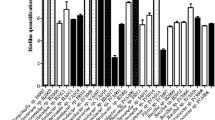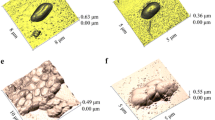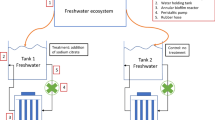Abstract
Biofilm-forming marine bacterium Paenibacillus lautus NE3B01 was isolated from a mangrove ecosystem, Odisha, India. This isolate formed a swarming type of colony pattern on the solid culture medium with 0.5–2 % agar. Phase contrast microscopy study of a growing colony of P. lautus on solid media and swarming pattern revealed the existence of two phenotypically distinct cells (i.e. cocci and rods) across the colonies. However, in actively growing planktonic culture, only rod-shaped cells were observed. Biofilm growth studies (crystal violet assay) with the isolate showed significant biofilm formation by 6 h, and the detachment phase was observed after 18 h. Biofilm parameters (such as total biomass, roughness coefficient, biofilm thickness, etc.) of 24-h-old P. lautus biofilm were studied by confocal scanning laser microscopy (CSLM). The CSLM study showed that P. lautus formed a biofilm with an average thickness of 14.8 ± 2.6 μm, a high roughness coefficient (0.379 ± 0.103) and surface to bio-volume ratio (4.59 ± 1.12 μm2/μm3), indicating a highly uneven topography of the biofilm. This also indicates that the 24-h-old biofilm is in dispersal phase. Scanning electron microphotographs of P. lautus also supported the existence of two distinct phenotypes of P. lautus. The current findings suggest that P. lautus has two vegetative phenotypes and to decongest the overcrowded biofilm the bacterium can switch over to motile rods from nonmotile cocci and vice versa.






Similar content being viewed by others
References
Be’er A, Florin EL, Fisher CR, Swinney HL, Payne SM (2011) Surviving bacterial sibling rivalry: inducible and reversible phenotypic switching in Paenibacillus dendritiformis. MBio. doi:10.1128/mBio.00069-11
Becker P, Hufnagle W, Peters G, Herrmann M (2001) Detection of differential gene expression in biofilm-forming versus planktonic populations of Staphylococcus aureus using micro-representational-difference analysis. Appl Environ Microbiol 67(7):2958–2965
Ben-Jacob E, Cohen I, Golding I, Gutnick DL, Tcherpakov M, Helbing D, Ron IG (2000) Bacterial cooperative organization under antibiotic stress. Phys Stat Mech Appl 282(1):247–282
Ben-Jacob E, Cohen I, Levine H (2000) Cooperative self-organization of microorganisms. Adv Phys 49(4):395–554
Dash H, Mangwani N, Das S (2013) Characterization and potential application in mercury bioremediation of highly mercury-resistant marine bacterium Bacillus thuringiensis PW-05. Environ Sci Pollut Res. doi:10.1007/s11356-013-2206-8
Debois D, Hamze K, Guérineau V, LeCaër JP, Holland IB, Lopes P et al (2008) In situ localisation and quantification of surfactins in a Bacillus subtilis swarming community by imaging mass spectrometry. Proteomics 8(18):3682–3691
Dubnau D, Losick R (2006) Bistability in bacteria. Mol Microbiol 61(3):564–572
Errington J (2003) Regulation of endospore formation in Bacillus subtilis. Nat Rev Microbiol 1(2):117–126
Fauvart M, Phillips P, Bachaspatimayum D, Verstraeten N, Fransaer J, Michiels J, Vermant J (2012) Surface tension gradient control of bacterial swarming in colonies of Pseudomonas aeruginosa. Soft Matter 8(1):70–76
Finkel SE (2006) Long-term survival during stationary phase: evolution and the GASP phenotype. Nat Rev Microbiol 4(2):113–120
González-Pastor JE, Hobbs EC, Losick R (2003) Cannibalism by sporulating bacteria. Sci Signal 301(5632):510
Hall-Stoodley L, Nistico L, Sambanthamoorthy K, Dice B, Nguyen D, Mershon WJ, Post JC (2008) Characterization of biofilm matrix, degradation by DNase treatment and evidence of capsule downregulation in Streptococcus pneumoniae clinical isolates. BMC Microbiol 8(1):173
Heydorn A, Nielsen AT, Hentzer M, Sternberg C, Givskov M, Ersbøll BK, Molin S (2000) Quantification of biofilm structures by the novel computer program COMSTAT. Microbiology 146(10):2395–2407
Ingham CJ, Jacob EB (2008) Swarming and complex pattern formation in Paenibacillus vortex studied by imaging and tracking cells. BMC Microbiol 8(1):36
Irie Y, Parsek MR (2008) Quorum sensing and microbial biofilms. In: Tony R (ed) Bacterial biofilms. Springer, Berlin, pp 67–84
Jain K, Parida S, Mangwani N, Dash HR, Das S (2013) Isolation and characterization of biofilm-forming bacteria and associated extracellular polymeric substances from oral cavity. Ann Microbiol. doi:10.1007/s13213-013-0618-9
Joshi HM, Rao TS (2009) Nutrition induced pleomorphism and budding mode of reproduction in Deinococcus radiodurans. BMC Res Notes 2(1):123
Kearns DB (2010) A field guide to bacterial swarming motility. Nat Rev Microbiol 8(9):634–644
Mangwani N, Dash HR, Chauhan A, Das S (2012) Bacterial quorum sensing: functional features and potential applications in biotechnology. J Mol Microbiol Biotechnol 22(4):215–227
Mangwani N, Shukla SK, Rao TS, Das S (2013) Calcium-mediated modulation of Pseudomonas mendocina NR802 biofilm influences the phenanthrene degradation. Colloids Surf B. doi:10.1016/j.colsurfb.2013.10.003
Markova N, Slavchev G, Michailova L (2012) Unique biological properties of Mycobacterium tuberculosis L-form variants: impact for survival under stress. Int Microbiol 15(2):61–68
Nadell CD, Xavier JB, Levin SA, Foster KR (2008) The evolution of quorum sensing in bacterial biofilms. PLoS Biol 6(1):e14
Noguchi H (1910) Pleomorphism and pleobiosis of Bacillus bifiduscommunis. J Exp Med 12(2):182–195
O’Toole G, Kaplan HB, Kolter R (2000) Biofilm formation as microbial development. Ann Rev Microbiol 54(1):49–79
Parsek MR, Greenberg EP (2005) Sociomicrobiology: the connections between quorum sensing and biofilms. Trends Microbiol 13(1):27–33
Roth D, Finkelshtein A, Ingham C, Helman Y, Sirota-Madi A, Brodsky L, Ben-Jacob E (2013) Identification and characterization of a highly motile and antibiotic refractory subpopulation involved in the expansion of swarming colonies of Paenibacillus vortex. Environ Microbiol 15(9):2532–2544
Sandal I, Hong W, Swords WE, Inzana TJ (2007) Characterization and comparison of biofilm development by pathogenic and commensal isolates of Histophilussomni. J Bacteriol 189(22):8179–8185
Shemesh M, Tam A, Steinberg D (2007) Differential gene expression profiling of Streptococcus mutans cultured under biofilm and planktonic conditions. Microbiology 153(5):1307–1317
Shukla SK, Sankar GG, Paraneeiswaran A, Rao TS (2013) Differential radio-tolerance of nutrition-induced morphotypes of Deinococcus radiodurans R1. Curr Microbiol. doi:10.1007/s00284-013-0472-9
Shukla SK, Rao TS (2013) Dispersal of Bap-mediated Staphylococcus aureus biofilm by proteinase K. J Antibiot 66(2):55–60
Shukla SK, Rao TS (2013) Effect of calcium on Staphylococcus aureus biofilm architecture: a confocal laser scanning microscopic study. Colloids Surf B 103:448–454
Verstraeten N, Braeken K, Debkumari B, Fauvart M, Fransaer J, Vermant J, Michiels J (2008) Living on a surface: swarming and biofilm formation. Trends Microbiol 16(10):496–506
Wainwright M (2000) Highly pleomorphic Staphylococci as a cause of cancer. Med Hypotheses 54(1):91–94
Acknowledgments
The authors would like to acknowledge the authorities of NIT, Rourkela and BARC Facilities, Kalpakkam for providing facilities. N.M. gratefully acknowledges the receipt of fellowship from Ministry of Human Resource Development, Government of India for doctoral research. S.D. thanks the Department of Biotechnology, Government of India for research grants on biofilm-based enhanced bioremediation.
Conflicts of interest
Authors of the manuscript declare no conflict of interest.
Author information
Authors and Affiliations
Corresponding author
Electronic supplementary material
Below is the link to the electronic supplementary material.
Supplementary material 2 (MPG 2589 kb)
Rights and permissions
About this article
Cite this article
Mangwani, N., Kumari, S., Shukla, S.K. et al. Phenotypic Switching in Biofilm-Forming Marine Bacterium Paenibacillus lautus NE3B01. Curr Microbiol 68, 648–656 (2014). https://doi.org/10.1007/s00284-014-0525-8
Received:
Accepted:
Published:
Issue Date:
DOI: https://doi.org/10.1007/s00284-014-0525-8




